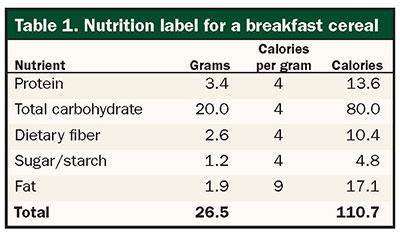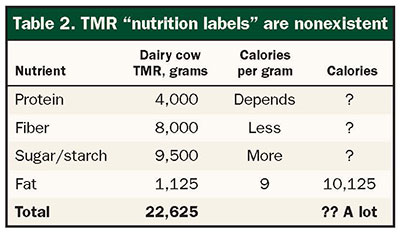The author is the director of nutritional research and innovation with Rock River Lab Inc., and adjunct assistant professor, University of Wisconsin-Madison's Dairy Science Department.

Thinking in terms of a nutrition facts label can help us better understand our ration's starch and fiber characteristics.
Would you believe me if I said that forage and feed nutritive analysis and ration formulation are similar in concept to the nutrition facts label on your favorite cereal box? While it may be hard to consider at first, nutrient content is coupled with digestion, equating to calories, nutrition and performance potential - which probably doesn't sound too far off from reviewing fiber and starch in the rations of your herds.
We can pick apart where the calories in your favorite cereal are derived from, in terms of protein, fat, sugars, fiber and starch. Multiplying the grams of protein and total carbohydrates (sugar, starch and fiber) per serving by roughly 4 and fat grams by 9 equates to the total calorie count per serving (Table 1).

Nutrition labels can seem oversimplified by assuming constant nutrient digestion for humans. For simplicity and to quickly assess foods at the grocery store, this makes sense. But, when focusing on personal nutrition, we rarely consider carbohydrates from broccoli or whole grains to yield the same calories as those from refined sugar. Reason being, complex carbohydrates have different digestion characteristics than refined sugars. The same concept holds true for carbohydrates in dairy cattle.
Historically, when performance has lagged, nutritionists added more grain and less forage despite the fact that fiber and starch are made of glucose chains. Fiber and starch, in chemistry terms, are actually similar in energy "potential" on a gram-for-gram basis.
Yet, experience has shown fiber and starch/sugar potential in rations to be very different. Why? For the same reason that broccoli is different from refined table sugar - calories available for dairy cow health and performance hinge on nutrient digestion. Fiber digestion is vastly different from starch, and fiber never equals starch. Sometimes the nutritionist mind forgets this key point.
While human nutrition fact labels are simple, unfortunately ruminant nutrition labels are painfully complex and do not exist, as the incomplete example in Table 2 shows. The missing calories per gram column in the table highlights the difficulty a nutritionist has in determining resulting ration calorie and performance level.

Rather than discussing approaches for estimating nutrient digestion, we'll focus on how digestion is carried forward and why each different nutrient within high-performing cattle is needed.
The very first step to nutrient digestion and performance is consumption. We tend to focus on rumen metabolism but often ignore that the TMR must be eaten first. Ensuring consistent mixing, delivery and then minimizing sorting throughout the day can help here. Our aim is to have the last bite of the day be identical to the first.
After consumption, the TMR is chewed, mixed with saliva, heads to the rumen to be further solubilized in bacteria-rich rumen fluid and then rechewed. The starch needs to first be solubilized, or dissolved, because digesting bacteria are actually in the rumen fluid. Bacteria then need to be in contact with the grains to kick off digestion. Cud chewing further mixes bacteria with grain particles and also reduces particle size, boosting the surface area to which bacteria, protozoa and fungi can attach. Starch digesting bacteria then break apart the starch molecules and grow, producing fermentation acids and microbial protein for the cow.
To gain an edge with your TMR starch digestion, reduce the grain's particle size. Pat Hoffman, with Vita Plus, and Randy Shaver, with the University of Wisconsin-Madison, have taught that particle size is a first limiting factor to starch digestion. The finer the starch, the greater the rumen and total tract starch digestion.
Similar to starch, fiber digestion starts by blending rumen fluid with forage particles and then breaking the fiber down through cud chewing, fungi penetration and bacterial digestion. Fiber actually digests from the inside out because lignin wraps the outer portion and prevents bacteria from attaching well. Rumen fungi play a key role in fiber digestion by breaking the cell wall with their hyphae (small, needle-like appendages which break the fiber).
Fiber digestion typically piggybacks on starch, sugar and other nonstructural carbohydrate digestion, with end products of quick digesting nutrients serving as a substrate to kick start fibrolytic bacteria. This process is called cross feeding. The bacteria then yield fermentation acids and microbial protein for the cow.
If you suspect fiber digestion is limiting performance, consider feeding less forage (less fiber) or replacing poor-quality forage neutral detergent fiber (NDF) with more digestible commodity feed NDF (such as wheat midds, soy hulls, corn gluten feed, almond hulls or beet pulp). Longer term strategies to improve NDFD (NDF digestibility) include a more aggressive harvest schedule and choosing elite seed genetics.
If nutrient digestion was as simple as described here, we would be much closer to perfect rations and common tank averages of 115 pounds per cow per day. Yet, there are countless interactions that take place between starch, fiber and other nutrients during digestion, which can both help and limit ration energy.
A classic example entails excessive starch load and digestion, resulting in substantial lactic acid production and a lower rumen pH which, in turn, limits the fiber digesting bacteria's ability to do their job. Moreover, in this case, a high-quality fiber could be poorly digested, purely because of starch load.
All-in-all, sometimes we can better assess opportunities on-farm by taking a step back and thinking differently, possibly in terms of a nutrition facts label. Work with your consulting team to formulate your herd's own nutrition facts label.
This article appears on page 720 of the November 2015 issue of Hoard's Dairyman.
Return to the Hoard's Dairyman feature page.

Would you believe me if I said that forage and feed nutritive analysis and ration formulation are similar in concept to the nutrition facts label on your favorite cereal box? While it may be hard to consider at first, nutrient content is coupled with digestion, equating to calories, nutrition and performance potential - which probably doesn't sound too far off from reviewing fiber and starch in the rations of your herds.
We can pick apart where the calories in your favorite cereal are derived from, in terms of protein, fat, sugars, fiber and starch. Multiplying the grams of protein and total carbohydrates (sugar, starch and fiber) per serving by roughly 4 and fat grams by 9 equates to the total calorie count per serving (Table 1).

Sugar and broccoli behave differently
Nutrition labels can seem oversimplified by assuming constant nutrient digestion for humans. For simplicity and to quickly assess foods at the grocery store, this makes sense. But, when focusing on personal nutrition, we rarely consider carbohydrates from broccoli or whole grains to yield the same calories as those from refined sugar. Reason being, complex carbohydrates have different digestion characteristics than refined sugars. The same concept holds true for carbohydrates in dairy cattle.
Historically, when performance has lagged, nutritionists added more grain and less forage despite the fact that fiber and starch are made of glucose chains. Fiber and starch, in chemistry terms, are actually similar in energy "potential" on a gram-for-gram basis.
Yet, experience has shown fiber and starch/sugar potential in rations to be very different. Why? For the same reason that broccoli is different from refined table sugar - calories available for dairy cow health and performance hinge on nutrient digestion. Fiber digestion is vastly different from starch, and fiber never equals starch. Sometimes the nutritionist mind forgets this key point.
While human nutrition fact labels are simple, unfortunately ruminant nutrition labels are painfully complex and do not exist, as the incomplete example in Table 2 shows. The missing calories per gram column in the table highlights the difficulty a nutritionist has in determining resulting ration calorie and performance level.

Rather than discussing approaches for estimating nutrient digestion, we'll focus on how digestion is carried forward and why each different nutrient within high-performing cattle is needed.
The starch story
The very first step to nutrient digestion and performance is consumption. We tend to focus on rumen metabolism but often ignore that the TMR must be eaten first. Ensuring consistent mixing, delivery and then minimizing sorting throughout the day can help here. Our aim is to have the last bite of the day be identical to the first.
After consumption, the TMR is chewed, mixed with saliva, heads to the rumen to be further solubilized in bacteria-rich rumen fluid and then rechewed. The starch needs to first be solubilized, or dissolved, because digesting bacteria are actually in the rumen fluid. Bacteria then need to be in contact with the grains to kick off digestion. Cud chewing further mixes bacteria with grain particles and also reduces particle size, boosting the surface area to which bacteria, protozoa and fungi can attach. Starch digesting bacteria then break apart the starch molecules and grow, producing fermentation acids and microbial protein for the cow.
To gain an edge with your TMR starch digestion, reduce the grain's particle size. Pat Hoffman, with Vita Plus, and Randy Shaver, with the University of Wisconsin-Madison, have taught that particle size is a first limiting factor to starch digestion. The finer the starch, the greater the rumen and total tract starch digestion.
The fiber story
Similar to starch, fiber digestion starts by blending rumen fluid with forage particles and then breaking the fiber down through cud chewing, fungi penetration and bacterial digestion. Fiber actually digests from the inside out because lignin wraps the outer portion and prevents bacteria from attaching well. Rumen fungi play a key role in fiber digestion by breaking the cell wall with their hyphae (small, needle-like appendages which break the fiber).
Fiber digestion typically piggybacks on starch, sugar and other nonstructural carbohydrate digestion, with end products of quick digesting nutrients serving as a substrate to kick start fibrolytic bacteria. This process is called cross feeding. The bacteria then yield fermentation acids and microbial protein for the cow.
If you suspect fiber digestion is limiting performance, consider feeding less forage (less fiber) or replacing poor-quality forage neutral detergent fiber (NDF) with more digestible commodity feed NDF (such as wheat midds, soy hulls, corn gluten feed, almond hulls or beet pulp). Longer term strategies to improve NDFD (NDF digestibility) include a more aggressive harvest schedule and choosing elite seed genetics.
The plot thickens
If nutrient digestion was as simple as described here, we would be much closer to perfect rations and common tank averages of 115 pounds per cow per day. Yet, there are countless interactions that take place between starch, fiber and other nutrients during digestion, which can both help and limit ration energy.
A classic example entails excessive starch load and digestion, resulting in substantial lactic acid production and a lower rumen pH which, in turn, limits the fiber digesting bacteria's ability to do their job. Moreover, in this case, a high-quality fiber could be poorly digested, purely because of starch load.
All-in-all, sometimes we can better assess opportunities on-farm by taking a step back and thinking differently, possibly in terms of a nutrition facts label. Work with your consulting team to formulate your herd's own nutrition facts label.











